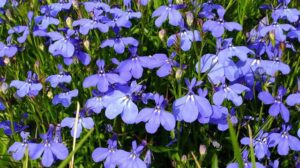Lobelia: This herb is a powerful poison that doesn’t belong on the home medicine shelf. That might be because it’s also referred to as “puke weed.” (Ugh!)
 Similar to nicotine,
Lobelia
Click to listen highlighted text!
Lobelia
is also called “Indian Tobacco” and has been used in over-the-counter preparations to help people stop smoking.
Similar to nicotine,
Lobelia
Click to listen highlighted text!
Lobelia
is also called “Indian Tobacco” and has been used in over-the-counter preparations to help people stop smoking.
However, there is no indication that it’s useful in this area.
It is believed that Lobelia, administered by a professional, may be a nurturing and supportive tonic for the lungs, applicable to a wide variety of upper-respiratory ailments particularly helpful in the treatment of asthma and bronchitis.
Externally, it may be useful in the treatment of arthritis, bruises, insect bites, poison ivy, ringworm and sprains.
The Lobelia Plant:
Canada and the northern United States are home to the this plant. The flowering plant has historically been used to make herbal treatments.
Medicine is produced from the above-ground components.
Uses & Precautions:
The use of lobelia as a herbal medicine for respiratory conditions, such as bronchitis, has a long history. It is a powerful expectorant, which means that it facilitates the removal of mucus from your lungs. However, lobelia has the potential to be harmful and should only be used under medical supervision.
Along with being sold in capsules, pills, and liquid extracts, it can also be purchased loose and dried to make tea. Different concoctions use the seeds, leaves, and flowers.
Constituents & Precautions:
Lobelia contains Lobeline and related alkaloids which act first by exciting and then depressing the central nervous system. It can open the bronchioles, if used in the right amount. However, too much and it slows respiration and lowers the blood pressure drastically.
Different doses have different effects. A half of a teaspoon of lobelia tincture may have a sedative effect but a whole teaspoon could cause you to vomit.

 Similar to nicotine,
Similar to nicotine,